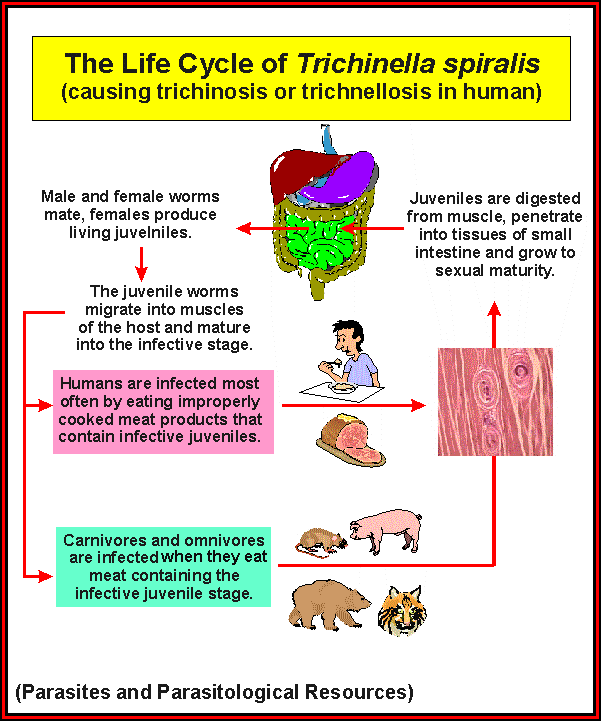

The roundworm Trichinella spiralis is killed at about 140 degrees F (actually at 137 degrees F). Because
thermometers can be inaccurate, most experts recommend cooking to 150 degrees F.
You can view or download a FREE (PDF File) CDC Fact Sheet |
| Other facts to keep in mind. |
* Trichinella is killed when pork is frozen at minus 5 degrees F for 25 days OR to minus 22 degrees F for 25 hours. |
* Ordinary curing and smoking does not kill Trichinella. (Trichinella also occurs in some wild game - this is what caused the problem with the cougar jerky mentioned above) |
* All cases of Trichinosis must be reported to the CDC. In 1998 there were 19 incidents of Trichinosis reported in the U.S. Most recent cases are among Asian immigrants (trichinosis is almost unknown in Asia - so eating rare or even raw pork is of no concern) and many other cases are from wild game (as the cougar jerky). |
* Trichinosis is not common in the US anymore, mostly due to changes in the methods of feeding of pigs over the last 30 years. (They don't feed them the raw intestines from slaughtered hogs ground up with their feed like they used to do - this was the main avenue of contamination on hog farms). |
| BOTTOM LINE: Use an accurate thermometer. Cook to 150 degrees F (medium) to be safe. Or if you are absolutely positive of your thermometers accuracy, 145 degrees. (Using frozen pork would be even safer). If you are very paranoid, use pork that has been frozen for a month or more in a commercial freezer at 10 degrees below 0 degrees F, and cook to 170 degrees. |
The BEST way to determine doneness of your pork is to use a high quality meat thermometer. The following web page from the USDA tells everything you need to know about meat thermometers! If you are interested in purchasing a high quality thermometer, we sell the exact same thermometer we use here at the Jackson Frozen Food Locker meat processing plant in our commercial smokehouse. Just click here to learn more! |
Aging PorkInstead cut and wrap it within 24 to 48 hours of slaughter.Only good quality Beef and Lamb should be “Aged” before cutting. |
Although trichinosis does not occur exclusively in pork, pork is the first thing that comes to mind and the reason Mom used to cook that pork to death until it had the taste and texture of shoe leather. Trichinosis is caused by microscopic live worms called trichinae. The parasites live and reproduce in the intestines and their larvae can make their way into the bloodstream and travel to the muscles causing pain, fever, muscle deterioration and even death. Nowadays, the threat of trichinosis is rare due to public awareness and strict government guidelines on the raising of pork. Pork (deer and bear are also targets) used to get infected with Trichinae via their diet of uncooked meats, either foraged or scraps. Now the US requires that even garbage must be cooked before using as feed for commercial hog stock. Government standards now assure that cured ham produced by responsible meat processors is free of trichinae. Cooking to an internal temperature of 137 degrees F. kills the parasite. Minimum government standards require cooked pork to reach 140 degrees F. internal cooking temperature. Canned hams are always cooked to the minimum, and in fact, require very high temperatures during the canning process. As such, when proper cooking procedures are followed, they are inherently erradicated of trichinae and safe. Freezing at a temperature of minus 10 degrees F. for several weeks will also kill Trichinae in pork (but not wild game). Interestingly enough, trichinae is not found worldwide. Southeast Asia and Europe have no problems with the parasite, allowing the consumption of raw pork without the risk of health problems. If you are purchasing your ham from a reputable retailer in the US, there is generally no need to worry about trichinosis, as long as you read the label and follow manufacturer's instructions for consumption. |
| Last Updated: Thursday, August 09, 2012 12:24 PM |